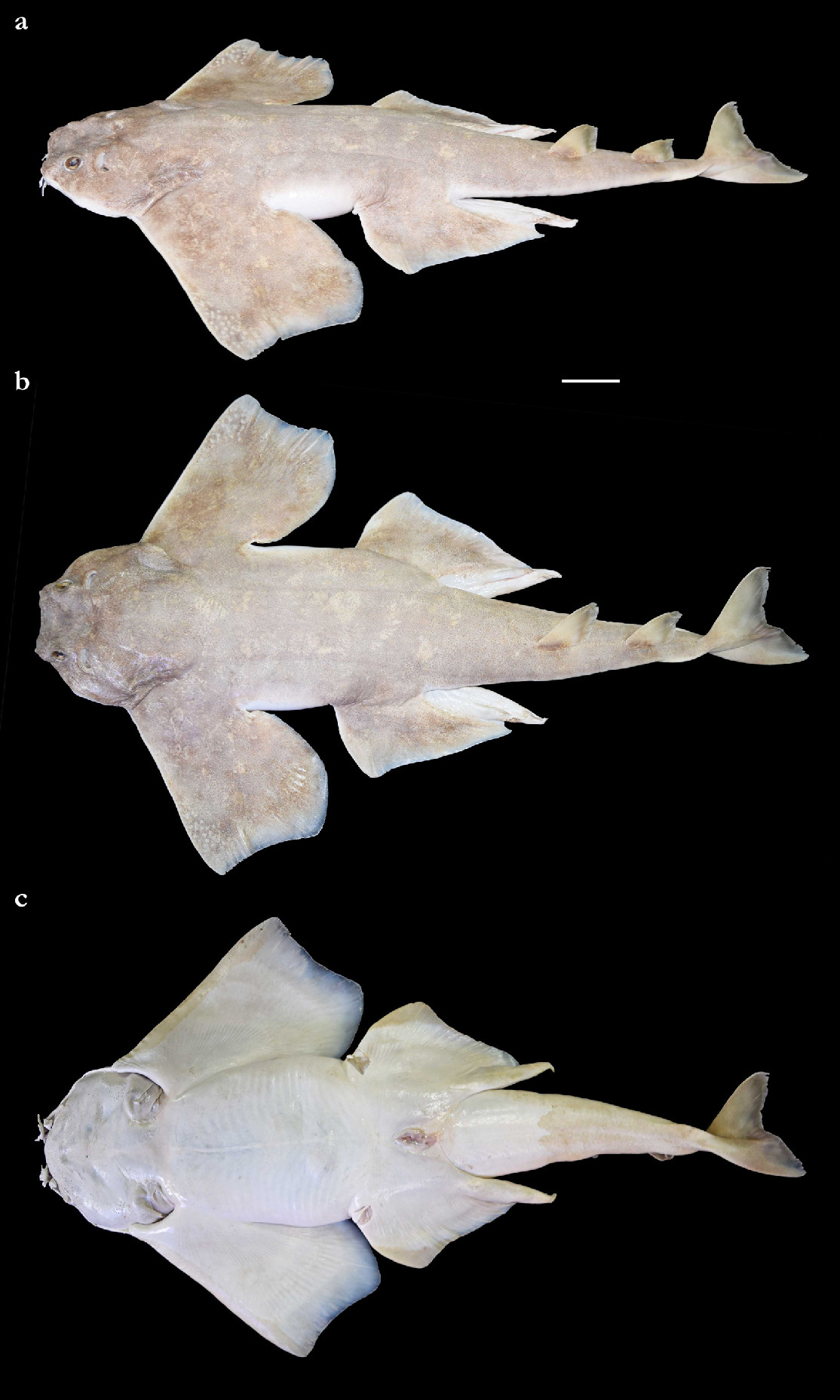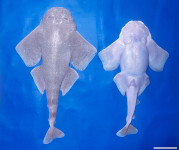Squatina leae
Weigmann, Vaz, Akhilesh, Leeney & Naylor, 2023
Classification: Elasmobranchii Squatiniformes Squatinidae
Reference of the original description
Revision of the Western Indian Ocean Angel Sharks, Genus Squatina (Squatiniformes, Squatinidae), with Description of a New Species and Redescription of the African Angel Shark Squatina africana Regan, 1908. Biology, 12(7), Article 975
Revision of the Western Indian Ocean Angel Sharks, Genus Squatina (Squatiniformes, Squatinidae), with Description of a New Species and Redescription of the African Angel Shark Squatina africana Regan, 1908. Biology, 12(7), Article 975
Types
Squatina leae
Holotype: CMFRI: GA. 15.2.5.4; Paratype: NSMT: P 117595; PMBC: 21219.01; PMBC: 21219.02; PMBC: 21219.03; PMBC: 21219.04; PMBC: 21219.05; PMBC: 21219.06; PMBC: 21219.07; PMBC: 21219.08; PMBC: 21219.09; PMBC: 21219.10; PMBC: 21219.11; PMBC: 21219.12; PMBC: 21219.13; PMBC: 21219.14; SAIAB: 84178; ZMH: 26097; ZMH: 26098; ZMH: 26099;
Squatina leae
Holotype: CMFRI: GA. 15.2.5.4; Paratype: NSMT: P 117595; PMBC: 21219.01; PMBC: 21219.02; PMBC: 21219.03; PMBC: 21219.04; PMBC: 21219.05; PMBC: 21219.06; PMBC: 21219.07; PMBC: 21219.08; PMBC: 21219.09; PMBC: 21219.10; PMBC: 21219.11; PMBC: 21219.12; PMBC: 21219.13; PMBC: 21219.14; SAIAB: 84178; ZMH: 26097; ZMH: 26098; ZMH: 26099;
Description :
Citation: Squatina leae Weigmann, Vaz, Akhilesh, Leeney & Naylor, 2023: In: Database of modern sharks, rays and chimaeras, www.shark-references.com, World Wide Web electronic publication, Version 12/2025
Please send your images of "Squatina leae" to info@shark-references.com

Squatina leae Weigmann, Vaz, Akhilesh, Leeney & Naylor, 2013, holotype, CMFRI GA. 15.2.5.4, adult male, 671 mm TL, scale bar: 5 cm © Weigmann et al. 2023

Squatina leae Weigmann, Vaz, Akhilesh, Leeney & Naylor, 2013, holotype, CMFRI GA. 15.2.5.4, adult male, 671 mm TL, scale bar: 5 cm © Weigmann et al. 2023
Common names
 Leas Engelhai,
Leas Engelhai,  Angelote de Lea,
Angelote de Lea,  Lea’s angel shark
Lea’s angel shark
 Leas Engelhai,
Leas Engelhai,  Angelote de Lea,
Angelote de Lea,  Lea’s angel shark
Lea’s angel shark
Short Description
Original diagnosis of Weigmann, Vaz, Akhilesh, Leeney & Naylor, 2023 [31911]: A small angel shark species (maximum size 870 mm TL) with the following characteristics: dorsal coloration conspicuously bright, beige to light grayish-brown, with many light yellowish flecks on trunk, and pectoral and pelvic fins, as well as countless densely set, minute dark spots, partially forming pseudocelli, all over the dorsal surface; no median row of scute-like denticles on trunk; anterior nasal flap with two lateral, elongate barbels and a medial rectangular barbel, all with ventral margins slightly fringed to almost smooth; concave between eyes; posterior nasal flap with an additional barblet; pectoral-pelvic space 10.0–14.9% TL; pectoral-fin apex angular; pelvic-fin free rear tips not reaching level of first dorsal-fin origin; tail moderately long, its length from cloaca 50.2–58.5% TL; pectoral fins moderately long, length 31.1–35.2% TL; dorsal fins not lobe-like; first dorsal-fin base somewhat longer than second dorsal-fin base; caudal fin of adults with angular apices; monospondylous centra 43–46; diplospondylous precaudal centra 55–58; total precaudal centra 100–104; total vertebral centra 130–136; and pectoral-fin skeleton with propterygium articulating with four radials.
Original diagnosis of Weigmann, Vaz, Akhilesh, Leeney & Naylor, 2023 [31911]: A small angel shark species (maximum size 870 mm TL) with the following characteristics: dorsal coloration conspicuously bright, beige to light grayish-brown, with many light yellowish flecks on trunk, and pectoral and pelvic fins, as well as countless densely set, minute dark spots, partially forming pseudocelli, all over the dorsal surface; no median row of scute-like denticles on trunk; anterior nasal flap with two lateral, elongate barbels and a medial rectangular barbel, all with ventral margins slightly fringed to almost smooth; concave between eyes; posterior nasal flap with an additional barblet; pectoral-pelvic space 10.0–14.9% TL; pectoral-fin apex angular; pelvic-fin free rear tips not reaching level of first dorsal-fin origin; tail moderately long, its length from cloaca 50.2–58.5% TL; pectoral fins moderately long, length 31.1–35.2% TL; dorsal fins not lobe-like; first dorsal-fin base somewhat longer than second dorsal-fin base; caudal fin of adults with angular apices; monospondylous centra 43–46; diplospondylous precaudal centra 55–58; total precaudal centra 100–104; total vertebral centra 130–136; and pectoral-fin skeleton with propterygium articulating with four radials.
Size / Weight / Age
TL (max) male: 717 mm TL, female: 870 mm TL, size at birth: 180 to 190 mm TL [31911]
TL (max) male: 717 mm TL, female: 870 mm TL, size at birth: 180 to 190 mm TL [31911]
Dentition
Small gradient monognathic heterodonty following Compagno [37]. Upper jaw teeth smaller than lower jaw teeth. Upper teeth from fourth to seventh rows approximately 1.5 times larger than those on the first three medial upper vertical rows. On lower jaw, teeth of medial and central vertical rows similar in size. In both upper and lower jaws, teeth of distalmost rows approximately one-half size of teeth on central rows. Upper jaw with 18 (18–20) and lower jaw with 18 (18–19) tooth rows; tooth formula: 9 + 9 (9 + 9 to 10 + 10)/9 + 9 (9 + 9 to 9 + 10). Tooth rows arranged without lateral overlapping (independent dentition of Strasburg [53]). Tooth morphology similar to other species of Squatina, with bulky triangular main cusp slanting lingually, without serrations and accessory cusplets. Crown base laterally expanded with prominent lateral heels [31911]
Small gradient monognathic heterodonty following Compagno [37]. Upper jaw teeth smaller than lower jaw teeth. Upper teeth from fourth to seventh rows approximately 1.5 times larger than those on the first three medial upper vertical rows. On lower jaw, teeth of medial and central vertical rows similar in size. In both upper and lower jaws, teeth of distalmost rows approximately one-half size of teeth on central rows. Upper jaw with 18 (18–20) and lower jaw with 18 (18–19) tooth rows; tooth formula: 9 + 9 (9 + 9 to 10 + 10)/9 + 9 (9 + 9 to 9 + 10). Tooth rows arranged without lateral overlapping (independent dentition of Strasburg [53]). Tooth morphology similar to other species of Squatina, with bulky triangular main cusp slanting lingually, without serrations and accessory cusplets. Crown base laterally expanded with prominent lateral heels [31911]
Remarks
shark-references Species-ID=16501;
shark-references Species-ID=16501;


















